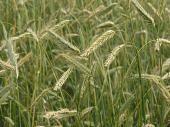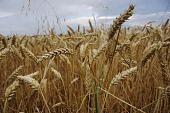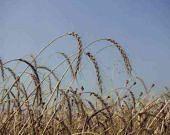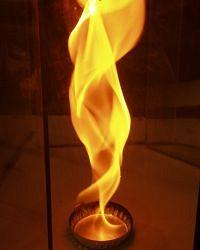
If you wish to understand yourself,
seek yourself in the wideness of the world;
if you wish to understand the world,
seek in the depths of your own mind.
Rudolf Steiner
Warmth: finding the core
Attitude
Warmth pervades you, or it can spontaneously arise within you when you become enthusiastic about something. You can use these features, pervasiveness and impulse creation, in making observations:
- pervasiveness by identifying with the object (a physical object or a situation), penetrating into it and at the same time allowing the object to enter your mental image;
- impulse creation by perceiving how the object has affected your soul and how it has induced you to act.
The observational attitude corresponding to the warmth element is based upon the characteristics or gesture of an object, and you search your mind to find its core and the impression it has made on you.
A comparison with a plant may clarify this idea. A fully grown plant with roots, leaves and flowers is something tangible. You don't have to imagine it, as it's there in front of you. But after the plant has died and has left only its seeds behind, you have to imagine the plant. The plant is present in the seed as a potential. It's as yet unclear exactly how it will turn out. It may become tall or short, stout or paltry, etc. The seed contains the plant as a whole potential range of appearances, while in an actual plant, one of these has manifested itself. In terms of observation, warmth as a mode of observation corresponds to the seed. It allows you to discover the core, the essence or the impulse, in which all manifestations of the object are potentially present.
You should allow all observations to enter your mental image: the concrete observations, the movements, the dynamic experience and the characteristics. You then make them disappear again, and wait to see if an image of the core or essence develops. This is an image of the impression created in you by your encounter with the object. Such an image is usually a symbolic image, and it is accompanied by an expression (its significance to you) or a certain mood. The symbolic image, with its expression, mood and orientation (that is, the direction in which it would seem to develop) contains all potential manifestations.
Since this observation of the symbolic image and its expression is personal, you may start to doubt whether it is accurate. You can test this by comparing images in a group of people. You will often find that different people come up with very different images for the same object, but that these images do express the same idea. If this is not the case, it often turns out that there were hidden differences in the questions you asked or the perspectives from which you observed.
Going from earth, via water and air, to warmth implies a movement from the exterior of an object to your own inner self. The observation has developed from a concrete observation, through movement, dynamic experience and gesture or characteristics to a symbolic image. This is a movement from exterior to interior and from a concrete manifestation to a symbolic image. It is a process of densification, of searching for the layer that is hidden behind that of the previous observations. It gets you ever closer to the core.
Strangely enough, this has also made the observation more objective. If different people make earth-type observations, they all observe on the basis of their own questions and concepts. Their observations are personal and therefore subjective, even though the concepts used may be objective. When observing a symbolic image, the observation is objective, even though the concepts used are personal and subjective.
If you're observing a farm or a landscape, you can also try to identify the intentions of the people who work there, that is, the impulses of the people who created it. You don't do this by asking them (as they would only tell you what they wanted to do), but you try to derive the intentions from what they actually did. Intentions reveal themselves in actions and can thus be observed. The aim is to discover the underlying intentions by studying the actions.
Meditative attitude
The warmth element corresponds to a meditative attitude. Here are some suggestions to achieve this.
- Meditation requires you to become calm and shut yourself off from your environment, from the noises around you and from your own spinning thoughts. Sit on a chair, put your feet on the ground. Sit up straight yet relaxed, and breathe quietly in and out. Continue like this until you've calmed down. Meanwhile, pay attention to the noises around you and gradually shut yourself off from them by no longer taking notice of them. Say 'Hello, noise'. Similarly, silence your thoughts by telling them to give way to something else. If they continue to trouble you, you can assign them to a particular place or tell them to come back in an hour or so. Now imagine you're in contact with the earth through your tailbone and with the sky through the crown of your head. Allow this to flow through you for a while.
- Now imagine that you're in a dome of light, with bright white light on the inside, while the outside is sealed off by a bluish violet light. Once you're calmly seated inside the dome, you call up mental pictures, images and perceptions of the object. You will see these as images before you. Call up earth-type, water-type and air-type observations in sequence. Do this for about 10 to 15 minutes. Once you're satisfied with the images, erase them. Tools that can help you do this if they refuse to go include a match with which you burn them or an eraser.
- Your mind is now empty, and you must wait and see whether a symbolic image arises, without explicitly wanting it to. You want it and at the same time you don't want it. You must wait and have faith. By wanting it too strongly, you will block its appearance. The image that arises is often a symbolic, imaginary image. It is often a well-known, common image, derived from fairy tales, the bible, etc.
- You can regard the image that arises as an impression that the object has evoked in you. It is an imprint of your encounter with the core, the essence of the object. It is not only the content of the image which is important, but also the intention, mood and orientation which it offers. The image expresses something. This is the impulse contained in it. It is important that you try to observe all this and record it (quickly) by jotting down notes, drawings, etc. If you don't, you may lose the precise expression. You can also ask the image questions. You can observe where it touches you and which movements it induces in you. These may relate to parts of your body but also to your thoughts, feelings or desires.
- You can go through all of these steps in one session, but you can also build up the observational images in the evening, and then wait until the morning, as you wake up, to see what image has arisen.
- If you now look at the object again, it may look completely different; it will often be brighter, more vivid, and you may notice new aspects.
- There are various ways in which this exercise can go wrong. The first problem is that you may find it impossible to shut yourself off from your environment and from your own thoughts. The next problem may arise in trying to concentrate on the object, as your thoughts may stray from it. One technique to help you with this is the first of Steiner's basic exercises (concentrating the mind). The next potential problem is in erasing the observational images, which may refuse to go or keep coming back. The final problem you may encounter is that no symbolic image ultimately appears, for instance because you want it too strongly. All of these problems can only be overcome by regular exercise.
Examples
Dog and cat
The image that arises for a dog is a circle, while that for a cat is a dot. The circle is appropriate for a dog because it is environment-oriented and open. The dot is appropriate for a cat because this animal tends to lie beside the stove, which is located at the centre. These features are also found in their posture and bodily traits, with cats having more rounded shapes and dogs having more elongated, radial shapes.



ReyWheat Spelt
Rye, wheat and spelt
A number of people have studied the developmental processes in three types of cereal. This led to the following images:
| rye | wheat | spelt |
|
|
|
Although these images are very different, there is a common quality. Compared to wheat and spelt, rye is associated with an active world, surrounded by blue. Wheat is associated with a completed development, which has reached its end and is no longer very active. The images associated with spelt have to do with youth and a development from the inside. (De Vries, 1985)
An ash
Two people participating in an exercise about an ash in a windbreak each saw an image while meditating. When they saw the tree again after their meditation, they both had the same reaction: the tree seemed more viable and brighter than before, and they noticed a branch they had missed before. None of the other participants showed this reaction.

Warmth: The pervasive element
Exercises
Inner peace and concentration
(see also: van de Weg, 2002 and Oehms, 2000)
• Stretch your entire body, starting from your toes; yawn if you feel the urge to do so. Let your upper body droop down, loosen your arms and head and then slowly raise yourself up again. Loosen your muscles by shaking them. Start with your feet, which you shake loose from the ankles, then your lower and upper legs, pelvis, hands, forearms and upper arms, shoulders, head and lower jaw. Tighten all your head muscles and then relax them again. Stretch yourself once more and let your upper body droop down again. Describe what you observe: how did you feel before and after the exercise?
• Sit down, in a relaxed attitude but straight. Focus your attention on the various parts of your body in turn, starting with your feet, ankles and so on up until you've reached the top of your head. Feel the location and weight of each of the parts of your body. Describe what you observe and how you felt before and after the exercise.
• All kinds of thoughts are actively running through your head. Call them up and look at them, then decide what to do with them. Throw away the unimportant ones (imagine something like a wastepaper basket) or make them fade into the background. Set the important ones aside, for instance by putting them on your desk. Continue this until your mind is empty. Now focus your attention on a spot at the centre of your head. This spot is empty and brightly lit. Make it larger. This is the space where mental images can arise. Were you able to empty your mind in this way? Did you create a bright empty space?
• Breathe quietly in and out, taking three to five seconds to inhale and exhale, holding your breath for three to five seconds after inhaling and also waiting three to five seconds after exhaling before inhaling again. After you've done this for some minutes and have calmed down, focus your attention on an empty spot in your chest. Did you manage to find an empty spot in your chest?
• Create a protective space by imagining yourself in a dome of light, with bright white light on the inside and bluish violet light on the outside. This dome will protect you against outside influences. Did you manage to create this space? Can you describe it?
• Create a meditation room. After you have completed the above exercises, and have decided to start meditating, your imagination may create a building that you can enter to meditate. After you have created this room, you can call it up when you wish to meditate. It doesn't matter what it looks like, as long as you're able to concentrate in it and feel comfortable there. Did you manage to create such a meditation room? What does it look like?
Mental image
Build up a rich, complete mental image of the object or situation that you want to use for warmth-type observations. First think of the concrete observations, then concentrate on the movement and dynamic experience, and then on the characteristics. Concentrate on these observations for 10 to 15 minutes, or however long you feel you need.
Now remove the mental image and wait to see whether a symbolic image arises. Describe or draw this symbolic image, paying attention to the intention and orientation of the image, what the image expresses and the mood associated with it. You should also pay attention to the impression the image makes on you and the part of you that is touched by it. You can also ask the image questions, like how it would prefer to develop.
